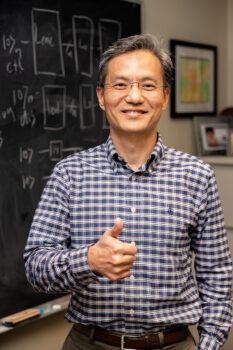Vet School Researchers Develop Virtual Tool For Studying Gene Function

Researchers at the Texas A&M University School of Veterinary Medicine and Biomedical Sciences (VMBS) have developed a new virtual tool that will allow scientists to study the function of genes more efficiently and hopefully reduce the number of animal models used in genetic research.
The tool, called Gene Knockout Inference (GenKI), allows scientists to simulate the relationship between genes in individual cells so they can study which genes affect cellular functions. Understanding the purpose of each gene is essential for developing new treatments for everything from cancer to the common flu.
“Molecular biologists and other scientists use what are called ‘knockout models’ to study targeted genes,” said Dr. James Cai, a VMBS professor in the Department of Veterinary Integrative Biosciences. “Scientists will delete — or ‘knock out’ — a gene in order to see what its function is. As we published in the journal Nucleic Acids Research, our newly developed virtual tool, led by my Ph.D. student Yongjian Yang, will allow researchers to study genes without using as many mouse models and will make it easier to see how genes interact with each other.”
Looking At The Bigger Picture
Discovering the function of each gene in an organism can be challenging. Humans have somewhere between 20,000 and 25,000 protein-coding genes, and some plants may have more than 40,000.
To make things more complex, genes often work together to govern different parts of the body, meaning knockout studies don’t always capture the full picture of gene function.
“Genes are part of a huge network,” Cai said. “They have partners, backups, and even long-distance relationships with each other. Sometimes it’s not easy to determine which genes are connected.
“When scientists want to study genes together, they can do what’s called a ‘double knockout,’ but it’s expensive and limited to two genes,” he said. “Theoretically, a virtual tool may be able to knockout two, three, or more genes as the technology grows.”
Another advantage to using a virtual tool for genetic research is that researchers can study cross-tissue response, or the relationship that genes may have between multiple tissues, organs and systems.
“It’s common for research labs to specialize in studying one aspect of the body, like the central nervous system or metabolism,” Cai said. “So, they tend to focus on studying tissue samples from one place, like the liver. But some genes may play more than one role, so we anticipate that using a virtual tool like GenKI that has access to multiple tissue cell types will make it easier to see those cross-tissue connections.”
Focusing On Essentials
Using a computerized tool is also beneficial because it allows researchers to study genes that they wouldn’t be able to study otherwise.
“When you’re working with tissues, you can’t knock out any genes that are essential for the body to function or else you won’t have a viable model,” Cai said. “This forces scientists to study the compensatory — or, secondary — effects of the gene, but not the target gene itself.
“With GenKI, we can stop the function of any gene and the simulation will still work,” he explained. “All we have to do is set the gene expression level to zero, or reduce it, and the tool will show us which other data points are affected by the change.”
GenKI also will allow scientists to get answers to questions earlier in the research process than would be possible when using tissues.
“You can start the simulation even if you’re only trying to answer preliminary questions,” Cai said. “Hopefully, as the technology develops, scientists will be able to rely more and more on the tool instead of animal models.”
The Future Of Genetic Research
Living organisms are incredibly complex, which makes the creation of digital simulations challenging.
“Right now, the tool can simulate gene relationships in individual cells from humans and mice,” Cai said. “We are starting with something simple in order to make sure that the tool is accurate.”
While the tool is still in development, Cai anticipates that as more people send his team data for different cell types, they will be able to expand the tool’s functionality while maintaining high levels of accuracy.
“Eventually, we expect to be able to simulate other cell types and even other organisms,” he explained.
“With this technology, we could reduce animal model use by 50% in 15 years or so,” he said. “But we can’t do it alone — it will take a culture change. It will take continued effort to build the tool so that researchers can rely on it.”
Media contact: Jennifer Gauntt, jgauntt@cvm.tamu.edu





